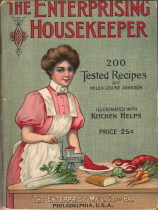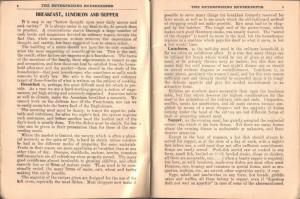 Here are pages 4, 5 and part of 6 from the vintage booklet The Enterprising Housekeeper, sixth edition (1906). If you’d like to follow along and browse through more pages of the book, I’m filing them in the Enterprising Housekeeper Category.
Here are pages 4, 5 and part of 6 from the vintage booklet The Enterprising Housekeeper, sixth edition (1906). If you’d like to follow along and browse through more pages of the book, I’m filing them in the Enterprising Housekeeper Category.
Breakfast, Luncheon And Supper
It is easy to say “bestow thought upon your daily menus and seek variety.” It is always easier to say than to do, to preach than to practice. A conscientious search through a large number of cook books and magazines devoted to culinary topics, reveals the fact that, while numerous writers reiterate the importance of thought and variety, few have suggested how to obtain either.
The building of a menu should not have for its only consideration the mere suggesting of something to eat. This is the end, the result; other factors are important as a foundation. The tastes of the members of the family, their requirements in respect to age and occupation, and how these can best be satisfied from the household allowance and the market–these should be the study of the housekeeper–that poor housekeeper, who sometimes so sadly needs someone to study her. She who is the unwilling and unhappy target of three-fourths of what is written on the subject of cooking.
Breakfast is, perhaps, the most difficult meal for which to provide. As a race we are a hard-working people; a nation of wage-earners, yet high strung and nervously organized. American habits as well as climate, make the American breakfast a necessity. We cannot work on the delicate fare of the Frenchman, nor can we so easily assimilate the heavy food of the Englishman.
The morning meal must be dainty, to tempt the appetite; palatable and nutritious, for after the night’s fast, the system requires such assistance, and before another meal the hardest part of the day’s work is usually done. Yet the dishes must be simple, for less time can be given to their preparation than for those of succeeding meals.
Where the market is limited, the variety, which is often a physical necessity as the spice of life, is hard to obtain unless resource be had in the different modes of preparing the same materials. Fruits in their season are more appetizing at breakfast than at any other time of day. Oranges, shaddocks, melons, berries, tomatoes and cucumbers are all refreshing when properly served. The many good cereals are almost invaluable to growing children, and often scarcely less so to those of mature years. These need to be occasionally varied, the many forms of maize, oats, wheat and barley making this easily possible.
The majority of the recipes given are designed for the use of the left overs, especially the meat dishes. Meat choppers now make it possible to serve many things for breakfast formerly reserved for later meals, as well as to use much which the old-fashioned method of chopping could not make possible. Raw meat had to be chopped by the butcher. The tough end of the porter-house, which makes such good Hamburg steaks, was usually wasted. The “sound of the chopper” is heard no more in the land, but the housekeeper rejoices in a machine which pays for itself in what it saves, in but a few weeks’ time.
Luncheon, as the mid-day meal in the ordinary household, is far too often an indifferent affair. It is true that many things can be utilized for lunch which would be out of place at any other meal, or be actually thrown away as useless; but this does not mean that the cold remains of last night’s dinner can or should be served without disguise or embellishment. Luncheon is, in many places, peculiarly the women’s meal, and for this very reason sufficient care and thought should be expended upon it to tempt the delicate appetite and give the needed nourishment in an attractive form.
Relishes are nowhere more acceptable than upon the luncheon table, but that which deserves the highest consideration for this meal is the utilization of the culinary odds and ends. Croquettes, soufflés, meats for sandwiches, and all meat entrees become simplified by means of a meat chopper; and the majority of dishes coming under the head of the entrees are but different forms of hash or preparing minced meat.
Supper, as the evening meal, has quietly accepted the neglected corner into which it has been thrust. Yet there are many homes where the evening dinner is undesirable or unknown, and these deserve attention.
Except in the heat of summer, a hot dish should always be served for supper, as at the close of a day of work, with a night’s fast before one, a cold meal does not offer sufficient nourishment. Soups are rarely served. Shell-fish served raw or cooked in any form; small fish, broiled or fried; broiled steaks, chops or chicken, all these are acceptable, especially when a hearty supper is required; but here, as with luncheon, made-over dishes are most often used. Potatoes, rice, hominy and tomatoes in special forms, such as croquettes, scallops, etc., are served; other vegetables rarely, if ever.
Eggs, salads and sandwiches in any form; hot breads, griddle cakes and waffles, all these belong to supper, even if “digestion doth not wait on appetite” in case of some of the aforementioned. Gelatine jellies; canned, preserved and fresh fruits, have a special place.
A classified list of dishes for breakfast, luncheon and supper is given, with a few suggestions for menus, in another portion of the book.
 More Recipes For You To Enjoy:
More Recipes For You To Enjoy:




